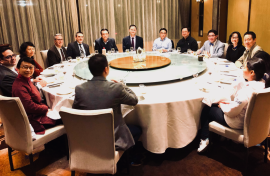Gangzhou, China —A delegation of eight Stanford Byers Eye Institute physicians and scientists, Jeffrey Goldberg, Quan Dong Nguyen, Daniel Palanker, Michael Kapiloff, Y. Joyce Liao, and Vinit Mahajan, traveled to Zhongshan Ophthalmic Center (ZOC) of Sun Yat-sen University for a Joint Symposium of Ophthalmology.

ZOC, one of the premier eye hospitals in China, is renowned for its excellent medical and preventive care, teaching, and research. The center dates back to 1835 when Dr. Peter Parker, an American missionary, founded the first western-style ophthalmology clinic in the country.
The major focus of the ZOC – Stanford Joint Symposium was exploring opportunities for research collaboration on eye disease with an emphasis on transforming scientific breakthroughs into products that promote health. The program included scientific presentations on advanced clinical and basic science research coming out of labs at the two universities. Panel discussions promoted an in-depth exchange of ideas.

Mahajan said, “We discovered right away that ZOC doctors are treating similar patients with a rare genetic condition. This led to our first joint investigation into the mechanisms of this gene mutation.”
ZOC is the only university in China to have a State Key Laboratory for Ophthalmology, approved by the Ministry of Science and Technology. In an effort to globalize Chinese ophthalmology and improve its international status, ZOC has sponsored “Grand Rounds Around the World,” and established relations with the World Health Organization and the NIH/NEI.
The ZOC Eye Research Institute has sub-specialty research departments that include glaucoma, corneal diseases, retinal diseases, eye tumor and orbital diseases, ocular plastics, trauma, strabismus and amblyopia, ametropia, neuro-ophthalmology, maculopathy, uveitis, hereditary ocular disease, conjunctivitis and xeroma.
Mahajan added, “We are looking forward to future exchanges that strengthen both of our clinical and research programs.”


